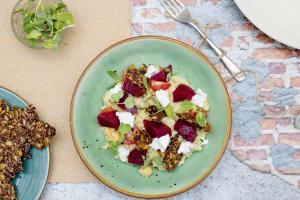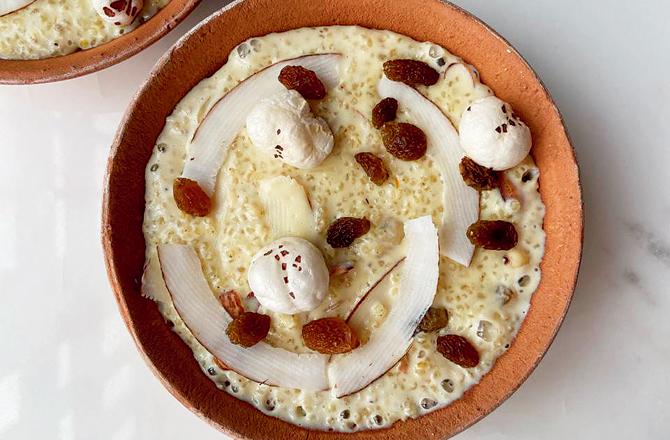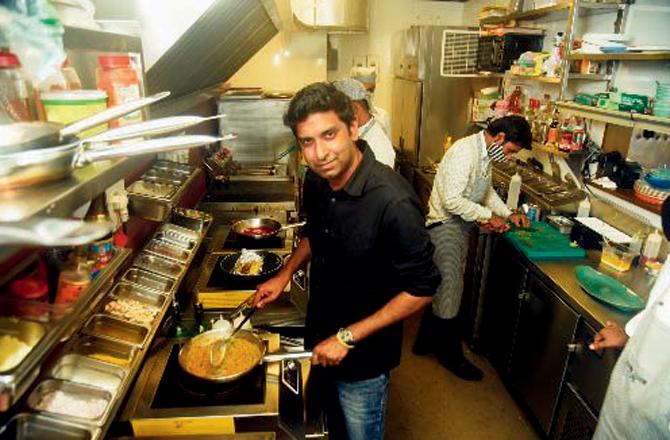Modest Indian grains are making a mark on the menus of progressive restaurants. We thought you should get to know them through forgotten recipes and newer twists

Ancient grain salad at Olive Mumbai. Pics/Atul Kamble
It's the time of the year when chef Vanshika Bhatia's Kanpur home fills with the divine aroma of kheer as it simmers on the stove. At the Bhatia family residence, the kheer isn't made from rice, but barnyard millet. The samakechawalki kheer is seasonal and made only in winters. "My mother would allow the sugars in the milk to caramelise well, giving the kheer its dense pink colour. Somehow, I haven't been able to replicate that, but every time I make this kheer, I am transported to the fasting days of Navratri when my mother, chachi and dadi would get together to make this," she says.

Chef Chirag Makwana
ADVERTISEMENT
Her mother's recipe is simple: A cup of barnyard millet soaked for four hours makes its way into a kadhai with two teaspoon ghee-roasted makhana, chironji and split cardamom. Five cups of milk are added with half a cup of sugar and slow cooked for hours till that beautiful pink glow is achieved. This is topped with slivers of dry coconut and makhana. Barnyard millet is a wild plant grown in the hilly regions of Uttaranchal and is high in iron. It is used to make khichdi, dosa and upma. "It's just what the body needs at this time of the year to fight disease and cold. Farmers favour it because it takes lesser water to grow [than other grains], making it ideal for the region in autumn," Bhatia adds.

Samakechawalki kheer is made every year during winter at Bhatia’s home in Kanpur
Millets belong to the family of grasses, develop slender stems and are known to make nutritious carb-free food. The fruit of the plant is what we eat as grain. Lifestyle coach and nutritionist Raksha Lulla explains, "Millets are seasonal-their power lies in the fact that every season has a different millet that is harvested. They have diverse micronutrients and a different response of cooling and heating effect on the body which makes them special to eat at a particular time of the year, with a unique pairing of vegetable or dal and pickle."

Chef Vanshika Bhatia
It's little wonder that chefs across progressive restaurants in the city are turning to little known grain to add uniqueness to their menu. For instance, the roasted cauliflower bowl by Olive Bar & Kitchen offers little millet (panicum miliare) pilaf with roasted cauliflower, creamy tahini, currants, sautéed spinach, dates and za'atar dressing. The other signature millet dish on the Union Park eatery's menu is the ancient grain salad made with kodo and foxtail millet, chickpea, crumbled feta, pickled beet shavings and a mustard and flax seed dressing. Chef Chirag Makwana, head chef, Olive Mumbai, says ancient grains are making a stupendous comeback. "We've seen our grandmothers use them extensively. Somewhere along the way, they disappeared from the scene. Now, as healthier grains like couscous and quinoa are being recognised worldwide, we are beginning to look inwards at our own produce for economic alternatives, and see that there is a plethora of local millets that have great nutritional value."

Raksha Lulla
What gives kodo millet an edge is how nutritive it leaves the land it is grown on, making it a farmer’s favourite
It's important, however, to differentiate grains from millets. Nutrigenomic counsellor, Dr Geeta Dharmatti says buckwheat (kuttu) and amaranth (rajgira) are not a part of Poaceae botanical family but nutritionally similar and are hence called pseudo millets. According to Lulla, the one benefit which is blanket across all millets is their fibre content, which can assist in fat loss, bowel movement and stabilising blood sugar levels. "This, in turn takes care of other metabolic disorders that stem from insulin resistance (diabetes, PCOD)." Nutrition wise, millets are considered a good source of fibre, with water absorbing and bulking properties, thereby increasing the transit time of food in the gut which helps in reducing risk of gastric disease and also diabetes, obesity and other non-communicable diseases. "It is food which gives good satiety with a slow energy release. Since they are gluten-free, they reduce inflammation in the body. Millets when malted, blend very well with pulses, milk and curd to give the complete amino acid profile. They are a good source of phosphorus and iron, but this iron needs to be made more bioavailable by adding vitamin C to the dish, such as lime or tomato, for instance," Dharmatti suggests.

Dr Geeta Dharmatti
Millets offer satiety with a slow energy release. Since they are gluten-free, they reduce inflammation in the body. When malted, they blend well with pulses, milk and curd to give the complete amino acid profile
Compared to jowar, ragi and bajra, kodo and proso are lesser known millets. "What gives kodo an edge is how nutritive it leaves the land it is grown on, making it a farmer's favourite. It has a brilliant texture and can be cooked like you would rice, or can be ground to make South Indian-style adai, pongal, upma and dahikodo," Lulla explains. Similarly, proso, a warm season grass is also easy to grow, needs less water and farming vanity. Once ground, it makes a good dosa batter option since the grain has a good fluff to it. Upma, idli, pongal and pula are other ways to eat it. "Both are easily prepared by toasting the millets lightly and then adding to boiling water or good vegetable stock. Add salt and simmer on low heat for about 15 minutes until the water has been absorbed."
Since the fibre from millets requires working in the small and large intestine, their breakdown in the system becomes favourable for its prebiotic effect and creates a healthy, diversely populated gut. Lulla says, "The good bacteria in the gut cuts down the inflammation, reducing migraine and improves mood. Since millets are chewy, their preparation also needs the dough to be made with hot water for the perfect elasticity. Taking time to chew food which is elastic and fibrous ensures that saliva and gastric acid production is higher. This increases stomach distention, slow movement of the food in the intestine and easy release of satiety hormones which signal the brain about fulfillment much sooner. This takes care of appetite and keeps the weight in check."

Chef Rohan D'souza
Chef Rohan Dsouza, culinary director at Silver Beach Hospitality, has given a spin to the indigenous grains with the yoghurt kasundi salmon on a bed of wild mushroom kodo millet khichdi. "The recipe is easy to whip up with mushrooms, yellow tadka dal and kodo with yogurt mustard salmon for the added protein to make it well rounded."

Yoghurt kasundi salmon on a bed of wild mushroom kodo millet khichdi
Kodo millet khichdi and yoghurt kasundi salmon
Ingredients
1 cup kodo millet
2 cup water
3 tbsp cooked masoor dal
1 tsp chopped onion
1/2 tsp garlic
1/2 tsp chopped onion
1/2 tsp chopped tomato
Soaked and sliced - 2 tsp dried mushroom (porcini and shiitake mixed)
1/2 tsp tamarind juice
1/4 tsp turmeric powder
1/4 tsp cumin powder
1/4 tsp chilli powder
200 ml soaked dried mushroom stock
2 tsp coriander chopped
1 tsp butter (optional)
Salt to taste
Method
Saute one cup millet lightly in a pan for two to three minutes, pour in two cups of water with salt and bring to a low boil for about 15 minutes till the water has absorbed. Once cooked, set aside. In a pan, sauté onion, garlic, tomato and spices over medium heat add in the cooked dhal. While cooking add the tamarind juice and mushroom stock. Adjust seasoning and finish off with chopped coriander and melted butter.
For baked yogurt mustard salmon
1 salmon steak
1 tsp kasundi mustard
3 tbsp yogurt
1/2 tsp garlic paste
Salt/pepper
1 green chilli finely chopped
Lemon juice
Make a marinade with all the ingredients and apply on the salmon steak, place in a silver foil and bake for eight to nine minutes. Serve with purple sprouted pickled cauliflower florets.
Keep scrolling to read more news
Catch up on all the latest Mumbai news, crime news, current affairs, and a complete guide from food to things to do and events across Mumbai. Also download the new mid-day Android and iOS apps to get latest updates.
Mid-Day is now on Telegram. Click here to join our channel (@middayinfomedialtd) and stay updated with the latest news
 Subscribe today by clicking the link and stay updated with the latest news!" Click here!
Subscribe today by clicking the link and stay updated with the latest news!" Click here!







